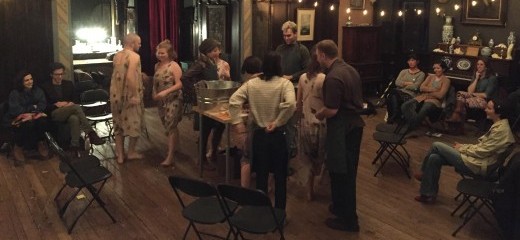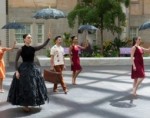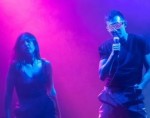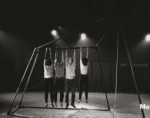
Sharing and holding this space with you
by Andrew Sargus Klein
Lights set at Light Cue #1 (warm celebratory wash) before show starts (no fade)
Before dancers enter, cue “Toast”
I’m not sure what a warm celebratory wash is, but I’m told the lighting designers will know. What I do know is that a light board probably won’t be able to recreate the diffuse light that is now pouring through the stained-glass windows on the second floor of Church on the Square in Baltimore. This place of worship—progressive, loving worship—is also the rehearsal space for Sharing a dance with you, created by Lynne Price, my partner, and it is one of two dance performances included in this year’s Charm City Fringe Festival. I’ve been brought on board as stage manager, and we are in one of our final rehearsals. The space is cavernous, almost swallowing Lynne and the other four dancers; the smallest sounds from voices and bodies are wrapped in deep reverb; the hardwood floor is a rich, golden brown. The movers enter the space after I call out the light cue—there is no fade up; this performance begins with little fanfare.
I have grown up with this performance. I watched it grow from a seed of an idea four years ago to an evening length work that culminated in Lynne’s MFA thesis at the University of Maryland in the fall of 2014. I saw it restaged at Baltimore’s Creative Alliance last year. It feels a part of my own emotional and artistic landscape. But stage managing isn’t watching; it’s the architecture of performance.
The performance is a variation on an in-the-round experience. The audience is grouped in twos and threes and spread out around a kitchen island so that the performers dance around, behind, and in front of them. Throughout the performance the audience will be asked to cook, help create choreography, and hold on to whispered secrets of deep pain. Through poetry, tender duets, surrealist prop choices, food, and dancing, the performance is deeply autobiographical without much apparent ego. Choreographically, there are often several overlapping points of emphasis: where you sit often determines your experience—sometimes to an extreme degree, as this performance is a journey where you’re asked to hold space for Lynne and offer real, physical support.
.jpg)
But I’m not thinking of that right now. I am trying to imagine bodies in the empty seats, 40-50 plastic folding chairs spread across the floor. As in an installation, the arrangement is purposeful and pregnant with expectation. This work is nothing if not an immersive experience.
Lynne begins the opening monologue with the words “This whole thing first started.” The “thing” is enormous. It’s transformation; it is healing and growth. This thing is about childhood trauma and recovery: recovery as process, as ongoing, as healing and wounding. “The princess and her prince fell madly in love and lived happily ever after,” Lynne continues. But that traditional end to a children’s story is only part of the beginning of this one. “Except this princess became overwhelmingly ill and landed herself in the hospital within four months of her happily ever after. Oh, and she was slowly rejecting her assigned role as princess, preferring instead simply human”—and as part of rejecting that assigned role, Lynne uses the pronouns “they” and “them” in self-reference, which you’ll see me use throughout this essay.
Nick finishes O’Hara poem, dancers grab audience members.
When audience members are at the table:
Light Cue #2 (lights fade down to half, cooler in tone)
My brother read “Having a Coke with You,” by Frank O’Hara, at our wedding, but I’m not thinking about that day as performer Nick Horan reads it now.
and the fact that you move so beautifully more or less takes care of Futurism
just as at home I never think of the Nude Descending a Staircase or
at a rehearsal a single drawing of Leonardo or Michelangelo that used to wow me
and what good does all the research of the Impressionists do them
when they never got the right person to stand near the tree when the sun sank
He’s speaking of a love that leaves art behind, and how what makes us ourselves—what and how and if we love and how and if we love ourselves—is greater than schools of thought and iconic works in museums. It’s a sentiment as mundane as it is vital. And I’m experiencing the push and pull of having an emotional investment in this work while needing to stay on top of light and sound cues. I’m looking for the right amount of distance. It’s difficult. This is Lynne’s story—but a story I am so familiar with it’s in my blood, too—and this story needs a stage manager.
This section ends in anxious chaos. It’s disconcerting and confusing—a sort of nameless terror invading the chest: the dancers are scattered throughout the space, speaking overtop one another as they describe the movements they’re making (“I’m going to move my arm like this now”; “I’m speaking at this level but I will begin to speak louder”). The audience’s attention is split as the dancers build in volume and urgency until Jenny starts counting, faster, louder, with more desperation.
By this point, five audience members have been asked to come to the kitchen island and start preparing a meal while the rest of the audience stays put. In an abrupt transition, the dancers will then ask the audience to “do a gesture!” and these gestures are in turn used to create movement sequences. It can be uncomfortable to suddenly be asked to move (something I note during every performance), but the discomfort usually dissolves into laughter. Once the work is done, the dancers shout, in unison, “What rich ingredients!”
Cue “Drone” and 20-sec fade to Light Cue #2
The darkness deepens, with or without a light board. We’re no longer rehearsing at Church on the Square. Now we’re at the performance venue, Church & Company. It’s a DIY space that coincidentally is also a former church. It’s dark, lit by tactful string lights that segment the enormous amount of space above our heads. This is our only day to run tech in the venue; tomorrow is opening night.
It takes over an hour to rearrange chairs, check audio cables, figure out lighting software. There is far less space for the dancers here than there was in the rehearsal space. This is the topography of performance. The floor is unfinished, and a little later Lynne will catch a deep splinter in the ball of their right foot. That’s when the run-through will end.
But right now Lynne is facing a mirror at the edge of the space, a mirror that will reflect their naked body back to them during each performance as they undress while speaking truths. Truths like this: “It is true I was raped as a child.” They speak their truths about their autoimmune disease, about their body, about the cost of trauma.

Lynne solos, starts telling truths; when Emma starts talking, cue “Drone Swirl”
Now Lynne is standing in a corner reciting the poem “Mostly, She Practices Falling” by Karen McCadden, while the rest of the dancers pair off into duets that alternate between tender comfort and an almost raw emotionality.
And it is true that we are incredibly lonely.
That man walking the sidewalks of your town
with a tangle of bicycle inner tubes
over his shoulder like a map of his heart,
running errands, studying a nest of bowls
in a shop window, which is also like a map
of his heart, may tell you he's given up on love.
It’s also November 8. We are all checking election returns on our phones, necks craned in the dark. Nothing looks good. The audio isn’t coming out of one channel. The lighting system is alien. We opt to only use the house string lights out of an unspoken need for efficiency. There is still so much to figure out.
This is the topography of grief.
Where is the edge of the heart, is what we want
to know. We are not afraid of words, we say.
All we can do is draw lines we cannot cross.
The words on the page are cursive,
the inner tubes of thought we build into
what fine things we wish for, the trajectory
of our falling bodies, the edges of what we
can say, the things we say to the night.
The tech run is arduous. Everyone is tired. One of the dancers almost collides with a boom during a lift. There’s so little space. It’s easy to forget that in the center of it all, a meal is being prepared by dancers and audience. Turnips, carrots and parsnips are being boiled. During the performances, a little column of steam will listlessly drift up into the great vaulted ceiling of the former church. It’s getting colder in this DIY venue but the aroma is still finding its way into my nose, my eyes—a little soft steam in the sepia light.
Once I held a bird in my hands. I held its wings
to its sides. Its feet dangled like the stems
of letters. There was no heft to it, just a cage
of bones. Just a cage of bones and feathers.
Just a house of air, craning its head toward
knowing something, staring into the middle
distance, suddenly calm. This is all I know.
“Drone Swirl” leads through Lynne’s poem; at end (“suddenly calm, period, this is all I know”), BEAT, cue “Whoosh” and immediate cut to black for 5 seconds
After 5 real seconds, cue 15-second fade up to Light Cue #2
Lynne has sent the dancers home. The lighting situation is too complicated, so we opt to just use the house lights. We didn’t make it to the end of the run on account of Lynne’s splinter. We had no idea the floor would be this bad, the space this small. We’re sharing this space with two other Fringe performances and it doesn’t seem as if there’s any space for our set. Somehow it’ll work out. Clinton has lost Ohio. Wisconsin isn’t looking good.
.jpg)
We didn’t make it to the end of the run, where the performance turns magical. After streaming back and forth diagonally through the space until their breath is ragged and sharp, Lynne stands still, eyes closed, all but sobbing. A dancer approaches and hugs them, and when she lets go Lynne still keeps their arms out for the next dancer to duck into the embrace. And the next. And the next. And like with every past performance of this work, the dancers will then ask the audience if they would like to support Lynne. As with every performance, a line forms. Cue Motherlode. One after another, audience members will duck under and step into an embrace with someone leaving themselves radically open to love, to support. We hold Lynne, perhaps with a kiss on the cheek, a mingling of shared tears of joy. It is an experience of undeniable togetherness. With almost every performance, someone tells Lynne that they too are a survivor. This performance is Lynne’s story, but in offering this story through collaboration and touch, it becomes everyone’s story.
We didn’t make it to that moment at tech tonight. Tomorrow we open and Donald Trump will be the president-elect and there are still questions about the venue but we will make it to that line of people waiting to embrace a stranger.
When hugs are done, as dancers approach Lynne, cue “Sing out.”
On opening night I will completely botch this cue, which all but ruins the moment after the hug line has finished, the moment where Lynne slowly rotates and thanks the audience with tear-filled eyes. I botch the cue; I step on this moment, and I dissolve into panic sweat, shaking with tears. I plead with myself to not be overwhelmed. There’s still more cues ahead. It’s almost time to eat. First we sing, loud and full.
Meal commences; 5-10 minutes of eating, cue “Secrets”
We eat. The cast enjoins the audience to create a circle, then teaches them a simple folk dance. They slip out one by one until it’s just the audience dancing, arm in arm.
After dancers have all exited during “Secrets,” cue “Shake it Off”
The performance ends as it began: no light cue, no formal introduction. I wasn’t perfect with my cues; I learned from mistakes while making new ones; I cried with each performance and each performance ended on an emphatically hopeful note of laughter and togetherness. Sharing a dance with you exists on the barrier between performance and lived experience, within both artmaking and self-exploration. There is food, there is dancing, there is love. This is what we hope to hold on to.
Sharing a dance with you, Church and Company, Nov. 9- 3.
By Andrew Sargus Klein
November 29, 2016










